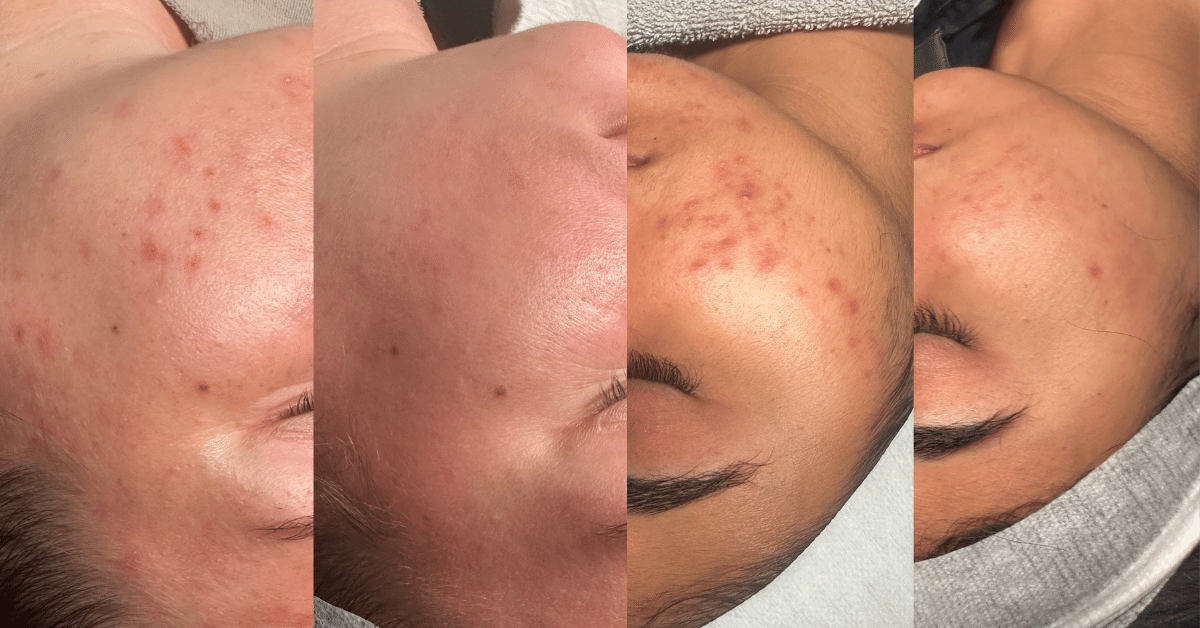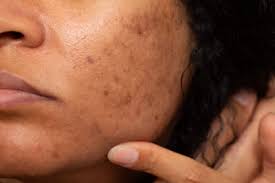
Our Blog

Hyperpigmentation | Causes, Types, Treatments & Prevention

If you’ve ever dealt with dark spots, uneven skin tone, or lingering marks after a breakout, you’ve experienced hyperpigmentation. It’s one of the most common skin concerns — and while it’s normal, it can be frustrating when you’re chasing a clear, even glow.
The good news? Hyperpigmentation is treatable. With the correct information, skincare routine, and lifestyle habits, you can visibly fade dark spots and prevent new ones from forming. Let’s explain exactly what hyperpigmentation is, its causes, and the most effective treatments and prevention tips.
Hyperpigmentation refers to any darkened area of skin caused by excess melanin production. Melanin is the pigment that gives our skin, hair, and eyes their color. When our skin becomes inflamed or triggered by specific factors, it can overproduce melanin, resulting in patches or spots that appear darker than the rest of the skin.
This can look different for everyone. For some, it shows up as a smattering of freckles or sunspots; for others, it’s larger patches or stubborn post-acne marks that won’t fade.
Common Types of Hyperpigmentation:
- Sunspots (Solar Lentigines): These flat, brown spots result from chronic sun exposure and typically appear on areas exposed to the sun — the face, chest, shoulders, and hands. They become more noticeable with age, hence the nickname “age spots.”
- Melasma: Characterized by symmetrical patches of discoloration, usually on the cheeks, forehead, chin, or upper lip. Melasma is often linked to hormonal changes — pregnancy, birth control, and hormone therapy can all trigger it — and is more common in women and those with deeper skin tones.
- Post-inflammatory hyperpigmentation (PIH): This type follows trauma or inflammation, such as acne, cuts, burns, eczema, or even overly aggressive treatments. As the skin heals, it may overcompensate by producing excess pigment in the area. PIH is especially common in people with medium to deep skin tones.
- Post-Inflammatory Erythema (PIE): This is not to be confused with PIH. PIE appears as red or pink marks and is caused by damaged or dilated blood vessels after inflammation. It is more common in lighter skin tones and often follows acne or irritation.
What Causes Hyperpigmentation?
Understanding the underlying causes can help you prevent it in the first place or keep it from worsening.
1. Sun Exposure
The sun is both your skin’s best friend and its worst enemy. Ultraviolet (UV) rays stimulate melanocytes (pigment-producing cells), which respond by increasing melanin production. While this is your body’s natural defense mechanism, it can lead to an overproduction that causes sunspots and darkens existing pigment.
2. Hormonal Changes
Hormones, particularly estrogen and progesterone, can increase melanin activity. This is why melasma is so common during pregnancy (hence the term “the mask of pregnancy”) or with the use of hormonal birth control.
3. Inflammation or Skin Injury
Any trauma to the skin can trigger pigmentation, especially in darker skin tones. This includes acne, eczema, psoriasis, cuts, burns, or harsh skincare products. The skin reacts by overproducing melanin as part of the healing process, leading to residual dark spots.
4. Genetics
Some people are genetically predisposed to hyperpigmentation. It runs in families and is more prevalent in medium to dark Fitzpatrick skin types, naturally producing more melanin.
5. Medications and Medical Conditions
Certain medications, like antibiotics, antimalarials, chemotherapy drugs, and anti-seizure meds, can increase your risk of pigmentation. Conditions like Addison’s disease or hemochromatosis can also affect melanin levels.
How to Treat Hyperpigmentation
There is no one-size-fits-all approach to treating hyperpigmentation. The best treatment plan will depend on your skin type, the cause of discoloration, and your lifestyle. However, successful treatment falls into three categories: topical skincare, professional treatments, and lifestyle adjustments.
1. Topical Skincare Ingredients
Topical treatments are often the first step; for many people, they’re all that’s needed with enough consistency.
- Retinoids (Retinol, Retinal, Tretinoin):
Vitamin A derivatives that speed up cell turnover, push fresh skin cells to the surface, and fade pigment over time. They also help prevent future breakouts, which means less PIH. - Vitamin C:
A potent antioxidant that inhibits melanin production, brightens existing dark spots, and defends against future UV-induced damage. Look for stable forms like Ascorbic Acid or Sodium Ascorbyl Phosphate. - Niacinamide (Vitamin B3):
It reduces inflammation, supports the skin barrier, and regulates melanin transfer. It is a great, gentle option for sensitive or acne-prone skin. - Azelaic Acid:
A favorite for treating both acne and pigment. It targets abnormal melanocyte activity and also has anti-inflammatory and antibacterial properties. - Kojic Acid, Licorice Extract, and Arbutin:
Plant-derived lightning agents that are ideal for targeting pigment without irritating the skin. - Alpha and Beta Hydroxy Acids (AHAs/BHAs):
These exfoliants help remove the top layer of pigmented, dead skin cells and allow other brightening ingredients to work more effectively. Glycolic, lactic, mandelic, and salicylic acids are popular choices.
Professional Treatments
Sometimes, you must bring in the pros to get faster, more noticeable results.
- Chemical Peels:
These use acids at higher concentrations to deeply exfoliate the skin and fade dark spots. Peels can range from light (e.g., lactic or mandelic acid) to deep (e.g., TCA) and are often done in a series. - Microneedling:
A treatment that uses fine needles to create micro-injuries in the skin, stimulating collagen and encouraging pigment to break up and resurface. Best results are seen in a series of treatments. - Laser Treatments:
Lasers like IPL (intense pulsed light), PicoSure, or fractional lasers target pigment at a deeper level. However, not all lasers are safe for all skin tones; those with deeper skin must be evaluated carefully to avoid burns or rebound hyperpigmentation. - Facials with Active Ingredients:
Brightening facials that incorporate exfoliation, vitamin C, enzyme masks, LED light therapy, or mild peels can be a great way to enhance your home routine.
SPF: The Non-Negotiable
You can do everything right, but your progress will be slow or nonexistent if you skip sunscreen.
- Use a broad-spectrum SPF 30+ daily, even on cloudy days.
- Reapply every 2 hours if you’re spending time outdoors.
- Opt for mineral sunscreens (zinc oxide, titanium dioxide) if you’re sensitive or acne-prone.
Consider tinted SPF for extra protection against visible light, which can worsen melasma and PIH in deeper skin tones.
Prevention Tips: How to Keep Pigment Away
Treating hyperpigmentation is one thing, but prevention is just as essential to avoid new spots and prevent old ones from returning.
- Stay consistent with sunscreen. Don’t just use it when it’s sunny. Make it a part of your morning routine, like brushing your teeth.
- Avoid picking at blemishes. We know it’s tempting, but picking leads to trauma and PIH.
- Use gentle skincare. Over-exfoliating or using harsh products can damage your barrier and lead to inflammation.
- Hydrate your skin. A healthy barrier helps reduce inflammation and supports an even tone.
Limit direct sun exposure. Wear hats and sunglasses, and seek shade, especially if using exfoliants or brightening agents.
When to See a Professional
If your pigmentation is persistent, severe, or causing emotional distress, it’s worth consulting a licensed esthetician or dermatologist. They can customize a treatment plan based on your unique skin and guide you through safe, effective options.
Hyperpigmentation is incredibly common, and yes, it’s treatable! There are solutions, whether you’re dealing with dark spots from acne, sun exposure, or hormonal shifts. With a solid skincare routine, professional treatments when needed, and sun protection, you can fade stubborn pigment and reclaim your glow.
Want help choosing the right products or treatments for your skin? Contact us for a personalized consultation. We’re here to help you love the clear, radiant, and healthy skin you’re in.

